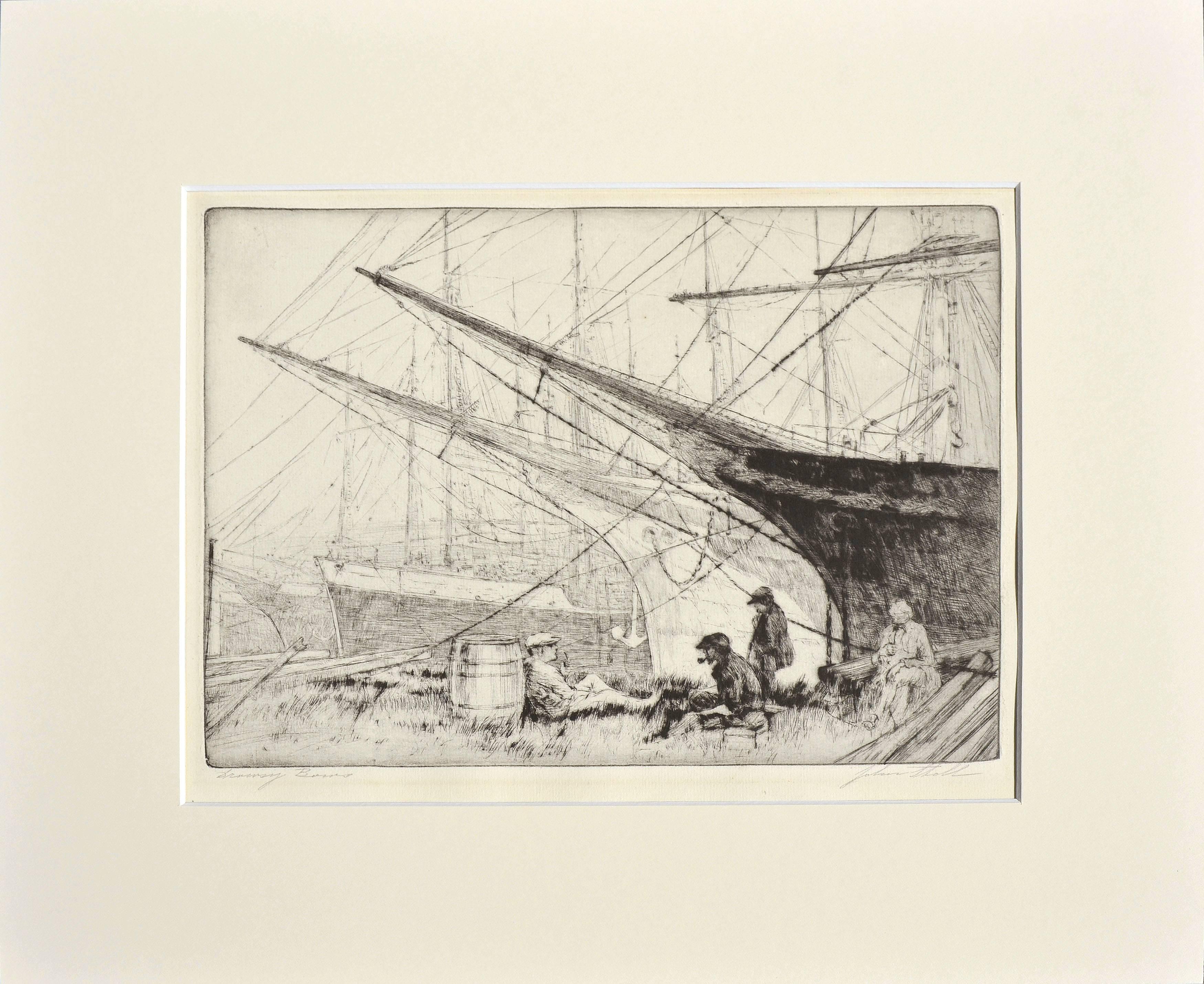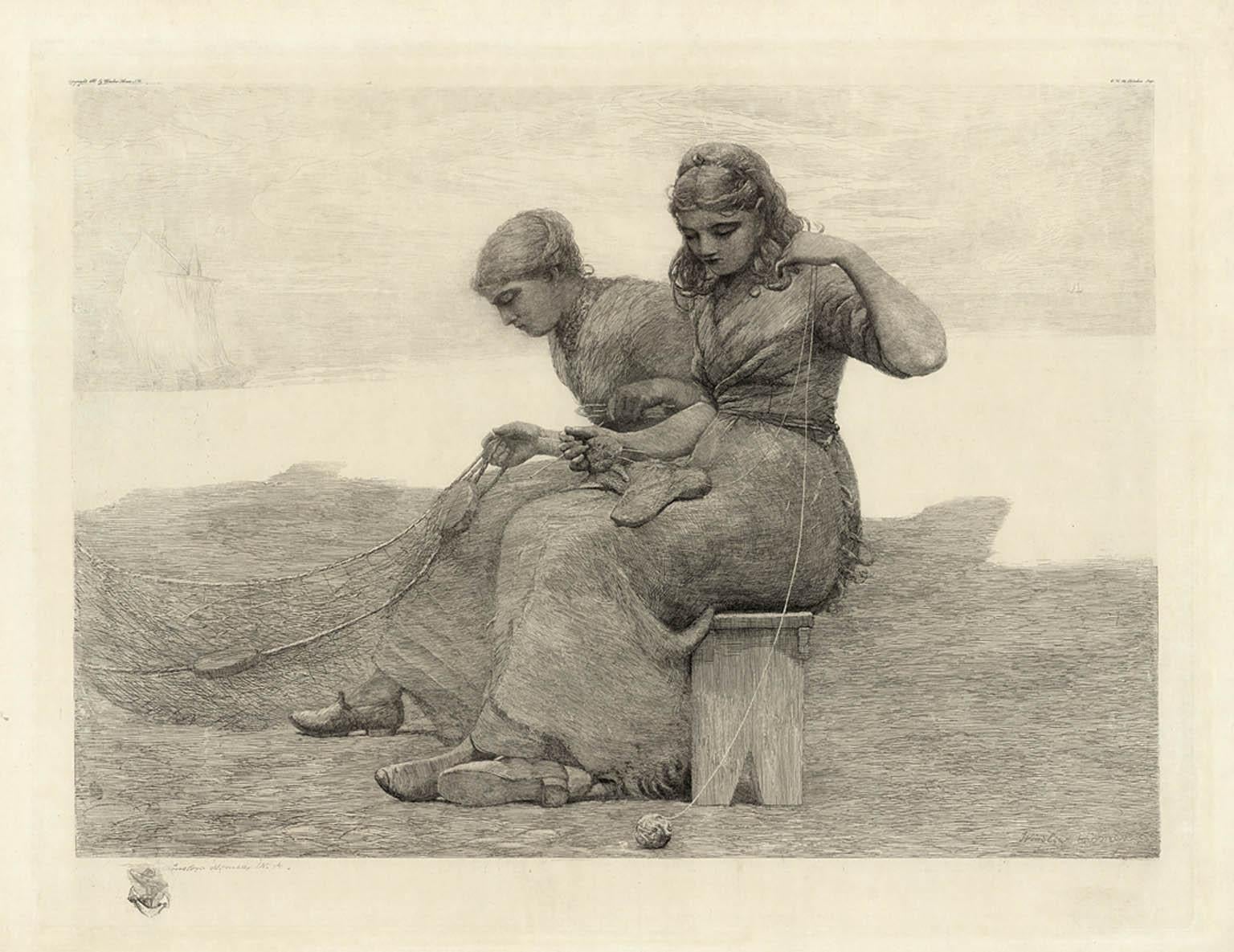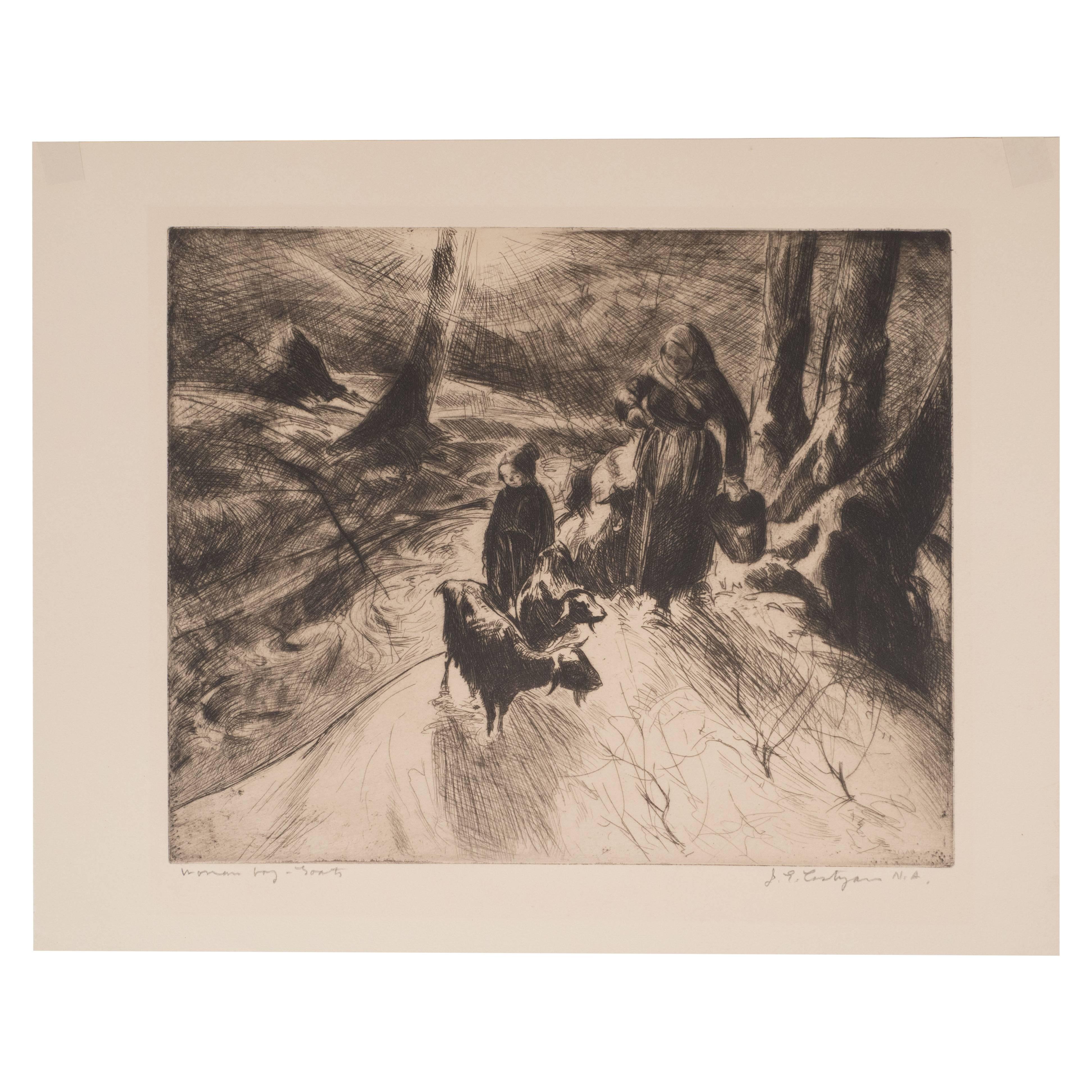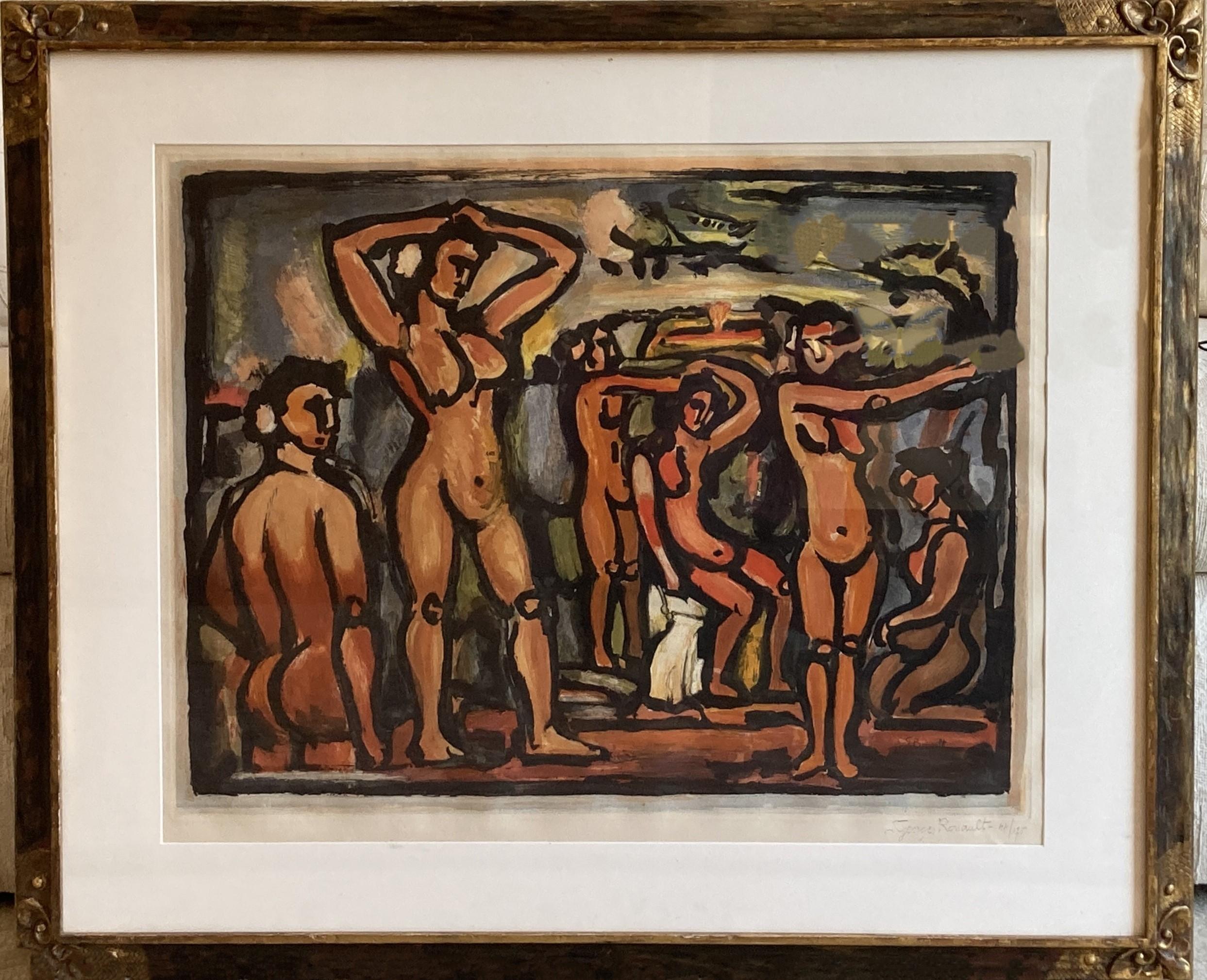Items Similar to Early 20th Century British Street Scene - 1920s Figurative Landscape Etching
Want more images or videos?
Request additional images or videos from the seller
1 of 10
E. Mary ShelleyEarly 20th Century British Street Scene - 1920s Figurative Landscape Etchingc. 1920s
c. 1920s
About the Item
Highly detailed figurative landscape lithograph of a street in London with a towering cathedral, old buildings, and figures walking the street below by E. Mary Shelley (English, late 19th Century). Signed "E. *Mary Shelley" (*Not the Author) in the lower right corner. Presented in a new cream mat. Unframed. Image size: 11.75"H x 7.75"W
E. Mary Shelley (English, late 19th Century) flourished in England in the 1920s and was shown at the Royal Academy of Art. She was mentioned in the Jan-Apr 1922 edition of “The Connoisseur” (An Illustrated Magazine for Collectors) - Walker’s Gallery devoted an entire room to her “conscientious etchings”.
- Creator:E. Mary Shelley
- Creation Year:c. 1920s
- Dimensions:Height: 15 in (38.1 cm)Width: 11 in (27.94 cm)Depth: 0.13 in (3.31 mm)
- Medium:
- Movement & Style:
- Period:
- Condition:Tonal ageing to paper, as expected for a piece of this age.
- Gallery Location:Soquel, CA
- Reference Number:
About the Seller
4.9
Platinum Seller
These expertly vetted sellers are 1stDibs' most experienced sellers and are rated highest by our customers.
Established in 1986
1stDibs seller since 2014
2,526 sales on 1stDibs
Typical response time: <1 hour
- ShippingRetrieving quote...Ships From: Soquel, CA
- Return PolicyA return for this item may be initiated within 14 days of delivery.
More From This SellerView All
- "Drowsy Bums" - Mid Century Figurative San Francisco Dock LandscapeBy John StollLocated in Soquel, CAFigurative landscape capturing dock workers' afternoon break by John Theodore Edward Stoll (b. Germany; 1889, d. California; 1974). Signed "John Stoll" lower right. Titled "Drowsy Bu...Category
1940s American Impressionist Landscape Prints
MaterialsEtching, Paper, Printer's Ink
- "Sharing" Multi Layer Screen Print on PaperLocated in Soquel, CAVibrant screen print of people gathering around a pond by Jane Leddy (American, 1925-2019). People and various animals - including goats, ducks, and cows - ...Category
1980s American Impressionist Figurative Prints
MaterialsPaper, Ink, Screen
- "Fisherman's Wharf - San Francisco" Multi Layer Screen Print on Paper - SignedBy Gordon CopeLocated in Soquel, CA"Fisherman's Wharf - San Francisco" Multi Layer Screen Print on Paper - Signed Rare and bold Screen Print (Silk Screen) of Fisherman's Wharf 1957 by Gordon Cope (American, 1906-1999). Several boats are docked at Fisherman's Wharf, with buildings directly behind them. In the distance, the hills of San Francisco can be seen meeting a pale blue sky. Of particular note is the skillful representation of the reflections of the boats in the water, and the clever use of grey paper as negative space. Numbered and titled in pencil in the lower left corner "22/100 Fisherman's Wharf - San Francisco" Hand signed and dated in pencil in the lower right corner "Gordon Cope 1957" Titled, signed, and dated "in plate" Presented in a silver colored frame with a double mat. Frame size: 22.5"H x 27"W Image size: 15"H x 20"W Gordon N. Cope (American, 1906-1999) was an educator and painter. Trained in Utah and France, he exhibited his landscape paintings and portraits in the United States and Europe, and he believed music was related to painting. Cope was born on May 14, 1906, in Salt Lake City. He was trained by Utahn artists LeConte Stewart and Lawrence Squires, and at the Académie Julian in Paris, France in 1928. He also studied singing at the Opéra-Comique. Cope taught art at Latter-day Saints University, and he served as the chair of its Department of Art in 1930–1931. He taught at the Mountain School of Art from 1932 to 1938, and he was the director of the Art Barn School in Salt Lake City in 1939–1941. Cope painted Utahn landscapes as well as a portrait of Henry H. Blood, who served as the seventh governor of Utah from 1933 to 1941. Cope exhibited his work in the United States and Europe. According to the Deseret News, Cope "felt that music and painting are closely interrelated, and that the study of one form may be used to complement the appreciation and understanding of the other." Cope died on June 10, 1999, in San Francisco, California. Gordon Nicholson Cope studied with well-known Utah artists A.B. Wright and LeConte Stewart, and became recognized as a major Utah artist of the Great Depression. Cope was born in Salt Lake City in 1906 and spent much of his life in Utah. Cope gained much of his artistic training from diverse environments and influences. Following his training with the previously mentioned artists, Cope spent the next year, 1924, working with Lawrence Squires in Arizona. To expand his knowledge and training, Cope traveled to Europe, where he studied the "old masters" such as Da Vinci, Michelangelo, and Raphael. From 1924 to 1928, Cope studied in England, France, Italy, Switzerland, Belgium, Holland, and worked for a year at the Acadamie Julian, where many early Utah artists...Category
1950s American Impressionist Landscape Prints
MaterialsScreen, Paper, Ink
- Late 19th Century Normandy French Market EngravingBy Charles John WatsonLocated in Soquel, CACharming engraving of the market in Aumale, France in Normandy by Charles John Watson (British, 1846-1927), circa 1880. Signed within engraving and below by artist. Presented under g...Category
1880s Impressionist Landscape Prints
MaterialsIndia Ink, Paper
- "Home from the Fair" Wagon and Horses Print on CanvasLocated in Soquel, CA"Home from the Fair" Wagon and Horses Print on Canvas Colorful print on canvas with additional oil brush strokes for detail by Texas artist Jack Terry (American, Born 1952). Limited hand signed edition of 108/250 hand embellished canvas prints. Hand signed in gold pen lower right "Jack Terry 108/250" Also signed in print "Jack Terry 1988" Ink Stamp on Canvas "Jack Terry hand Painted Canvas Print" Brass plaque center on linen "Home From the Fair" Image, 16"H x 20"W Frame, 24"H x 28"W x 2.5"D Jack Terry’s paintings evoke emotion in the viewer encompassing subject matter, use of color, mood and grace of light. He is one of the most collected artists of our time. Jack was born in the west Texas town of Sweetwater in 1952 and began his art career as a young child, winning his first of many awards at the age of nine. A fourth-generation Texan, he credits much of his inspiration to his maternal Grandfather, Bill Mason, a rancher who cowboyed on some of the last cattle drives of the west and his paternal Grandmother, Etna Terry, who began painting late in life and welcomed young Jack to participate in the fun. Six-time world champion Cowboy Larry Mahan has said of Jack, “Terry captures the West the way it was and the way it should be. He is one of the finest artists of our day and a pretty good cowhand to boot…”. A graduate of the University of Texas, Jack studied studio art, anatomy, design and journalism while displaying his paintings in various galleries throughout the state. Upon graduation, he began painting full-time, taking every opportunity to day-work on various ranches in search of inspiration, new subject matter and authenticity. In 1976, at the young age of 24, Jack Terry was named Bicentennial Artist in Texas. He was honored with a one-man show in the state Capitol Rotunda. His portrait of President Lyndon Johnson was commissioned for publication on the Texas Bicentennial Calendar that same year. In 1999, Harvest House Publishers invited Jack to write and illustrate his first book. “The Great Trail Ride”, a collection of 14 inspirational short stories. The great success of that first title led to eight more books which sold over one million copies. In 2008 First Lady Laura Bush invited Jack to the White House for the Holiday Celebration. He painted a Christmas tree ornament representing the state of Texas. In 2010 the United States Army commissioned a painting honoring the First Air Calvary Division and the brave men and women who have served from the historic beginning of the U.S. Calvary, Viet Nam and the Middle East. Limited edition reproductions were signed by Jack, Medal of Honor Recipient Bruce Crandall from the Viet Nam War, and General Dick Cody, Vice Chief of Staff, U.S. Army. Jack responded about this special occasion in 2010, “After months of research, flying time and researching films and most importantly sitting at the same table with these heroes whose commitment, loyalty and sacrifice to our great nation have made this the most meaningful painting I have ever done”. Jack Terry’s paintings hang in prominent collections throughout the country. The King Ranch...Category
1980s American Impressionist Figurative Prints
MaterialsCanvas, Printer's Ink, Oil
- "Under the Apple Tree", Figurative Chromolithograph after George Niles, 188/250By Louis PrangLocated in Soquel, CAOriginal chromolithograph by Louis Prang (German/American, 1823-1909) of L. Prang & Co. (American, founded 1860), after "Under the Apple Tree" by George E. Niles (American, 1837-1898). This late 19th century figurative chromolithograph depicts a small boy in a country setting and period dress under an apple tree, reaching into a barrel with a basket of apples spilling into the grass. A German style chromolithograph, this limited edition 188/250 print was created with heavy, oil-based inks which were applied in several layers to impart a texture similar to an original oil painting. Signed and dated in the plate "G.E. Niles 1867". Tag on verso with "Prang's American Chromos - Under the Apple Tree, after Niles - Chromolithographed and published by L. Prang & Co. ...Boston". Displayed in a rustic giltwood beveled frame. Image size: 9"H x 7.25"W. Louis Prang was a foremost lithographer and publisher in New York City from the mid to the end of the 19th Century. Born in Breslau, Germany to a father who was a calico printer, he was an apprentice to his father during his teen-age years and then spent five years as a journeyman, learning printing and dyeing and living in Austria, France and England. However, Prang's liberal political vliews caused him to be deported by the Prussian government during the Revolution of 1848, and fled via Bohemia and Switzerland to get to America. In 1850, Prang went to Boston, having stopped briefly in New York City, and became a publisher and taught himself wood engraving. In 1856, he turned to lithography in partnership with Julius Mayer. In 1860, he founded Louis Prang and Co., which was his own company and the first stiff competition to Currier and Ives. A primary reason for this competition was Prang's active imagination and energetic pursuit of his business. During the Civil War, he published maps and battle plans so that people at home could follow military movements. He also created printed card portraits of Union soldiers...Category
Late 19th Century American Impressionist Figurative Prints
MaterialsLithograph, Cardboard
You May Also Like
- Over the Hill and Far Away and Magenta Sky diptychLocated in Deddington, GBOver the Hill and Far Away and Magenta Sky Overall size cm : H31 x W40 Over the Hill and Far Away by Karen Keogh [2018] limited_edition Etching on Pape...Category
21st Century and Contemporary Impressionist Figurative Prints
MaterialsPaper, Etching
- BillingsgateBy James Abbott McNeill WhistlerLocated in Middletown, NYEtching printed in dark brownish black ink on cream laid paper, 6 x 8 7/8 inches (152 x 226 mm); full margins. Extremely minor and unobtrusive band of toning along the top sheet edg...Category
Mid-19th Century Impressionist Landscape Prints
MaterialsDrypoint, Laid Paper, Etching
- Mending the TearsBy Winslow HomerLocated in New York, NYWinslow Homer created this etching entitled “MENDING THE TEARS” in 1888. This is a lifetime impression signed by Homer and printed by the famous New York etcher George W. H. Ritchie...Category
1880s American Impressionist Figurative Prints
MaterialsEtching
- "Woman, Boy and Goats", Original Signed Etching by John E. CostiganBy John CostiganLocated in New York, NYThis original, limited edition etching, was realized by the esteemed American artist John E. Costigan, who is represented in the collections of the Metropolitan Museum, the Philips Memorial Gallery in Washington and the Brooklyn Museum, to name only a few of the many institutions that feature his work. This print, with its highly considered composition and its loose style of figuration- deftly balances realism and abstraction- helps to explain his acclaim. This etching features a mother walking with her child and two goats in a forested glen. It is a Classic pastoral scene rendered in Costigan's inimitable style- somewhere between Theodore Rousseau and Thomas Hart Benton. These offer a beautiful glimpse of a bygone American pastoral...Category
1930s American Impressionist Figurative Prints
MaterialsEtching
- Automne (Autumn)By Georges RouaultLocated in Storrs, CTAutomne (Autumn). 1938. Aquatint print in colors. Chapon/Rouault 288C. 19 1/2 x 25 1/2 ( sheet 22 5/8 x 30 3/4). Edition 175, #44 Published by Vollard. A rich impression with bright...Category
Mid-20th Century Impressionist Figurative Prints
MaterialsAquatint, Color
- Querelle d'amoureux. (Quarreling). 1By James TissotLocated in Storrs, CTEn plein soleil. (In the Sunlight). 1881. Etching and drypoint. Tissot 54, Béraldi 45, Wentworth 54. 7 13/16 x 11 1/2 (sheet 11 1/4 x 15). Edition about 100. Mat line and two hinge s...Category
19th Century Impressionist Figurative Prints
MaterialsDrypoint, Etching
Recently Viewed
View AllMore Ways To Browse
20th Century Etching Lithograph
1920s Etching
Etchings New England
English Cathedral
English Walking
Etching Cathedral
Shelley C
19th Paper Cathedral
Van Braam
Donald Sultan Oranges Print
Dark Red Backpack
Perego Vintage
Ann Burnham
Hiroshige Bridge
Prince Charles Signed Lithographs
Kind Of Cyan Palm
Mother And Child Cartier
Peter Max Brown Lady





